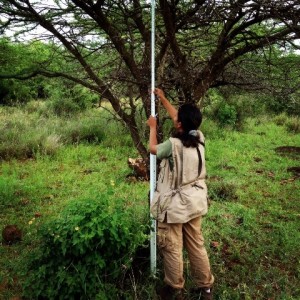Suren
The last eight months were the best part of the MRes program for me. After ending the intensive four months of lectures, assignments and exams, it was time to begin our research projects.
My research focused on elephant movement and resource utilisation in a fenced environment. I carried out my research in Lewa Wildlife Conservancy, Kenya, under the supervision of Dr. Zeke Davidson, Marwell Wildlife and Professor Patrick Doncaster, University of Southampton. I spent ten weeks in Lewa carrying out field work for data collection, from late March until the end of May. It was lovely to be back in Lewa for the second time and it was great to have fellow MRes student, Beth, with me, whose research was also based on Lewa.
Lewa Wildlife Conservancy is a fenced protected area with purposely built fence gaps to facilitate wildlife movement. Lewa’s elephant Loxodonta africana population has increased in the recent past and there is concern that damage caused to plants by the elephants are affecting the availability of vegetation for Lewa’s black rhino Diceros bicornis population. Exclusion zones have been established, separated by a two strand electric fence, to protect rhino browse. This fence is set up about 2m above the ground to prevent elephants passing through but allowing for the entry of smaller herbivores.
Unfortunately elephants keep breaking the exclusion fences and are continuing to cause damage to the plants within these exclusion zones. There are also concerns that insecurity events such as poaching, road banditry, livestock theft etc. occurring in surrounding areas might be driving elephants towards Lewa. Therefore, my study comprised of several components: one part looked at information from existing databases maintained by Lewa Wildlife Conservancy on elephant movement through fence gaps and on insecurity incidents to determine the effect of hostile events in surrounding areas on elephant movement. I also compared speed of elephant movement within Lewa and outside, using GPS collar data provided by Save the Elephants organisation from their long term elephant monitoring project. The other part involved a vegetation sampling survey in exclusion zones to determine the intensity of damage to plants and to compare how elephants and rhinos utilise woody vegetation. I also carried out camera trapping at exclusion zone fences to try to capture fence breaking incidents.
- Setting up a camera trap with a local ranger
- Measuring the height of vegetation in exclusion zones
It was a great experience at Lewa with some wonderful and caring people who taught me many new things. Every day at Lewa was eventful and extraordinary. For example, I was able to experience black rhino ear notching and rhino translocation operations. There were also many game drives and a wonderful walk in the Ngare Ndare forest to see the water fall. I am very grateful to everyone at Lewa, for all their support and friendship throughout my stay.
On my return to the UK, I had the opportunity to present a poster containing some of my preliminary results at the Spatial Ecology and Conservation 3 conference held at University of Bristol in July 2015. This was a wonderful chance for me to learn some current and applied topics on spatial analysis used in conservation biology and also to meet and network with professionals in the field.
The final stage of the research project was stressful, as expected, but all of us got through the thesis submission and presented some fantastic masters research projects. Final presentation and viva days were filled with mixed emotions as it marked the end of our program. All good things come to an end, but I am looking forward to meeting the new cohort of MRes Wildlife Conservation students before I return home to Sri Lanka.
Posted By : dvf1e13


